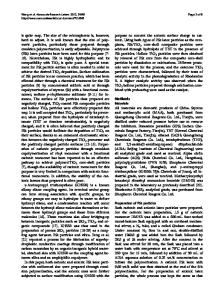Defects and Their Distribution in KH 2 PO 4 Crystals with Embedded TiO 2 Nanoparticles
- PDF / 9,683,582 Bytes
- 6 Pages / 612 x 792 pts (letter) Page_size
- 23 Downloads / 358 Views
Defects and Their Distribution in KH2PO4 Crystals with Embedded TiO2 Nanoparticles Valentin Grachev 1, Romand Tse 1, Ian Vrable 1, Igor Pritula 2, Olga Bezkrovnaya 2, Anna Kosinova 2, Vasyl Yatsyna 3, Vladimir Gayvoronsky 3, and Galina Malovichko 1 1 Physics Department, Montana State University, Bozeman, 264 EPS bldg., MT 59717, U.S.A. 2 Institute for Single Crystals, NAS of Ukraine, Lenin ave., 60, 61001, Kharkіv, Ukraine 3 Institute of Physics, NAS of Ukraine, Nauki ave., 46, 03680 Kiev, Ukraine
ABSTRACT Results from the successful growth of high quality KH2PO4 (KDP) crystals with incorporated TiO2 anatase nanoparticles and the characterization of these crystals using several complementary methods are presented. Transmission and scanning electron microscopy have shown that the anatase nanoparticles were captured mainly by the pyramidal growth sector and, to a considerably lesser extent, by the prismatic growth sector. Energy dispersive x-ray analysis confirms that the growth layer stacks contain the TiO2 particles. Significant variation in the imaginary and real parts of the cubic nonlinear optical susceptibilities and refractive index changes at continuous wave excitation were found in prism and pyramid parts of pure KDP and KDP:TiO2 samples. The identified lines of electron paramagnetic resonance belong to four different centers FeA3+, FeB3+, CrR3+ and CrGB3+. From analysis of line intensities it was concluded that the concentration of non-controlled impurities in nominally pure KDP samples is several times larger than in KDP:TiO2, and that the concentration of non-controlled impurities in the prismatic part of the KDP:TiO2 boule is larger than in the pyramidal part. INTRODUCTION Improvement of functional properties of materials for potential applications is always a topic of interest in material science. One of the ways to the improvement is the material doping with special ions, molecules or nanoparticles. The doping or nanoparticle embedding can drastically change structures of intrinsic and extrinsic defects in the materials. This leads in turn to changes in physical properties which cannot be easily predicted on the basis of common sense and basic knowledge. Detailed study of defect systems is required in order to understand the reasons for these changes and to create composite materials with desirable properties. In the present work we report about the growth procedure of KDP crystals with incorporated TiO2 nanoparticles and results of characterization of these crystal with the help of several complementary methods: transmission and scanning electron microscopy (SEM and TEM), energy dispersive x-ray analysis (EDAX), Fourier transformation infrared spectrometry (FTIR), measurements of nonlinear optical response at continuous wave excitation, and electron paramagnetic resonance (EPR). It was found that TiO2 nanoparticles create layered super-lattice with a distance of about 15 μm between the growth layers. Nanoparticles attract non-controlled impurities causing their clusterization, change structural and me
Data Loading...











